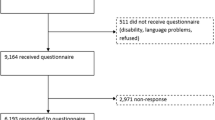Abstract
The SF-36 Health Survey is the most widely used self-report measure of functional health. It is commonly used in both randomized controlled trials (RCT) and non-controlled evaluation of medical or other health services. However, determining a clinically significant change in SF-36 outcomes from pre-to-post-intervention, in contrast to statistically significant differences, is often not a focus of medical outcomes research. We propose use of the Reliable Change Index (RCI) in combination with SF-36 norms as one method for researchers, provider groups, and health care policy makers to determine clinically significant healthcare outcomes when the SF-36 is used as a primary measure. The RCI is a statistic that determines the magnitude of change score necessary of a given self-report measure to be considered statistically reliable. The RCI has been used to determine clinically significant change in mental health and behavioral medicine outcomes research, but is not widely applied to medical outcomes research. A usable table of RCIs for the SF-36 has been calculated and is presented. Instruction and a case illustration of how to use the RCI table is also provided. Finally, limitations and cautionary guidelines on using SF-36 norms and the RCI to determine clinically significant outcome are discussed.
Similar content being viewed by others
References
Roper WL, Winkenwender W, Hackbarth GM, et al. Effectiveness in health care: An initiative to evaluate and improve medical practice. N Engl J Med 1988; 319(18): 1197-1202.
Ware JE, Brook RH, Rogers WH, et al. Comparison of health outcomes at a health maintenance organization with those of fee-for-service. Lancet 1986; 1(8488): 1017-1022.
Newhouse J. Patients at risk: Health reform and risk adjustment. Health Aff 1994; 13(1): 132-146.
National Center for Health Statistics. Health, United States. Washington, DC: US Government Printing Office 1998; Publication no. (PHS) 89-1232.
McHorney CA, Tarlov AR. Individual-patient monitoring in clinical practice: Are available health status surveys adequate? Qual Life Res 1995; 4(4): 293-307.
McHorney CA, Ware JE, Lu R, Sherbourne DC. The MOS36-item short-form health survey (SF-36): III. Tests of data quality, scaling assumptions, and reliability across diverse patient groups. Med Care 1994; 32(1): 40-66.
Keller SD, Majkut TC, Kosinski M, Ware JE. Monitoring health outcomes among patients with arthritis using the SF-36 health survey. Med Care 1999; 37(5 Suppl): MS1-MS9.
Nelson EC, Berwick DM. The measurement ofhealth status in clinical practice. Med Care 1989; 27(3 Suppl): S77-S90.
Nelson EC, Wasson J, Kirk J, Keller A, Clark D, Dietrich A. Assessment off unction in routine clinical practice: Description ofthe COOP chart method and preliminary findings. J Chronic Dis 1987; 40(1): 55S-69S.
Ware JE. The status ofhealth assessment 1994. Ann Rev Public Health 1995; 16: 327-354.
Kendall PC. Clinical Significance. J Consult Clin Psychol 1999; 67(3): 283-284.
Clancy C, Eisenberg J. Outcomes research care: Measuring the end results ofhealth care. Science 1998; 282: 245-246.
Wyrwich K, Wolinsky F. Identifying meaningful intra-individual change standards for health-related quality of life measures. J Eval Clin Prac 2000; 6(1): 39-49.
Jacobson NS, Traux P. Clinical significance: A statistical approach to defining the meaningful change in psychotherapy research. J Consult Clin Psychol 1991; 59(1): 12-19.
Jacobson NS, Follette WC, Revenstorf D. Psychotherapy outcome research: Methods for reporting variability and evaluating clinical significance. Behav Ther 1984; 15(4): 336-352.
Jacobson NS, Roberts LJ, Berns SB, McGlinchey JB. Methods for defining and determining the clinical signifi-cance oftreatment effects: Description, application, and alternatives. J Consult Clin Psychol 1999; 67(3): 300-307.
Ware JE, Snow KK, Kosinski M, Gandek B. SF-36 Health Survey Manual and Interpretation Guide. Boston: The Health Institute, New England Medical Center, 1997.
Testa M. Interpreting quality of life clinical trial data for use in the clinical practice ofantihyper tensive therapy. J Hypertension 1987; 5(1): S9-13.
Author information
Authors and Affiliations
Corresponding author
Rights and permissions
About this article
Cite this article
Ferguson, R.J., Robinson, A.B. & Splaine, M. Use of the Reliable Change Index to evaluate clinical significance in SF-36 outcomes. Qual Life Res 11, 509–516 (2002). https://doi.org/10.1023/A:1016350431190
Issue Date:
DOI: https://doi.org/10.1023/A:1016350431190



